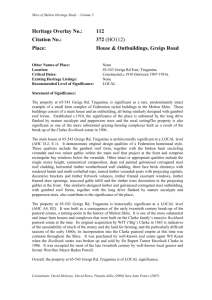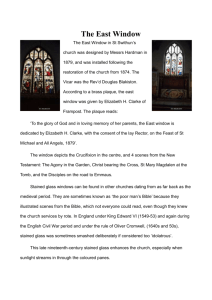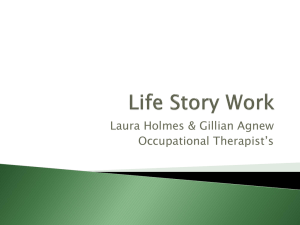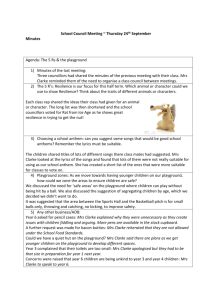Plumpton Park
advertisement
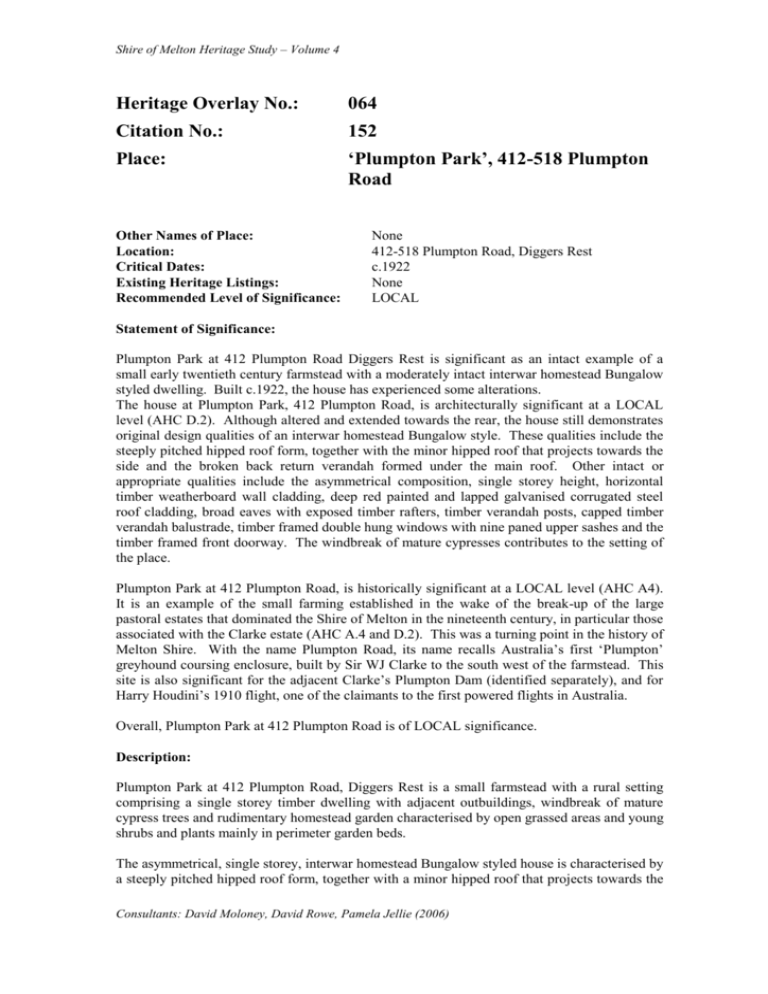
Shire of Melton Heritage Study – Volume 4 Heritage Overlay No.: 064 Citation No.: 152 Place: ‘Plumpton Park’, 412-518 Plumpton Road Other Names of Place: Location: Critical Dates: Existing Heritage Listings: Recommended Level of Significance: None 412-518 Plumpton Road, Diggers Rest c.1922 None LOCAL Statement of Significance: Plumpton Park at 412 Plumpton Road Diggers Rest is significant as an intact example of a small early twentieth century farmstead with a moderately intact interwar homestead Bungalow styled dwelling. Built c.1922, the house has experienced some alterations. The house at Plumpton Park, 412 Plumpton Road, is architecturally significant at a LOCAL level (AHC D.2). Although altered and extended towards the rear, the house still demonstrates original design qualities of an interwar homestead Bungalow style. These qualities include the steeply pitched hipped roof form, together with the minor hipped roof that projects towards the side and the broken back return verandah formed under the main roof. Other intact or appropriate qualities include the asymmetrical composition, single storey height, horizontal timber weatherboard wall cladding, deep red painted and lapped galvanised corrugated steel roof cladding, broad eaves with exposed timber rafters, timber verandah posts, capped timber verandah balustrade, timber framed double hung windows with nine paned upper sashes and the timber framed front doorway. The windbreak of mature cypresses contributes to the setting of the place. Plumpton Park at 412 Plumpton Road, is historically significant at a LOCAL level (AHC A4). It is an example of the small farming established in the wake of the break-up of the large pastoral estates that dominated the Shire of Melton in the nineteenth century, in particular those associated with the Clarke estate (AHC A.4 and D.2). This was a turning point in the history of Melton Shire. With the name Plumpton Road, its name recalls Australia’s first ‘Plumpton’ greyhound coursing enclosure, built by Sir WJ Clarke to the south west of the farmstead. This site is also significant for the adjacent Clarke’s Plumpton Dam (identified separately), and for Harry Houdini’s 1910 flight, one of the claimants to the first powered flights in Australia. Overall, Plumpton Park at 412 Plumpton Road is of LOCAL significance. Description: Plumpton Park at 412 Plumpton Road, Diggers Rest is a small farmstead with a rural setting comprising a single storey timber dwelling with adjacent outbuildings, windbreak of mature cypress trees and rudimentary homestead garden characterised by open grassed areas and young shrubs and plants mainly in perimeter garden beds. The asymmetrical, single storey, interwar homestead Bungalow styled house is characterised by a steeply pitched hipped roof form, together with a minor hipped roof that projects towards the Consultants: David Moloney, David Rowe, Pamela Jellie (2006) Shire of Melton Heritage Study – Volume 4 side and a broken back return verandah formed under the main roof. These roof forms are clad in early deep red painted and lapped galvanised corrugated steel. Broad overhangs with exposed timber rafters are features of the eaves. A feature of the design is the return verandah. It is supported by introduced square timber posts that have decorative timber brackets. A capped timber balustrade forms the verandah boundary. Other early features of the design include the timber framed double hung windows with nine paned upper sashes, and the timber framed front doorway. A flat roofed verandah and skillion wing at the rear and side have been introduced. History: Contextual History The ‘Plumpton Park’ farm homestead is situated on Sections 6, Crown Allotment 2, Parish of Holden. This allotment, of 318 acres 2 roods and 33 perches was sold to WJT (‘Big’) Clarke on 13th August 1857.1 Allotments to its north, south, east and west had also been purchased by Clarke at Crown Land sales in the years 1852 to 1857. The property became a part of the immense Rockbank estate assembled by Clarke, and then managed by his son Sir WJ Clarke. In 1882 this particular property became the focus of Sir WJ Clarke’s leadership of the sport of greyhound coursing in Australia. At that time there were no tracks or enclosures and greyhounds pursued hares across country. The first officially recognised public coursing meeting held in Australia, in which hares were the game coursed, was held in 1873 on Clarke’s Rupertswood property. On the 14th of August 1874, Rupertwood hosted Australia’s inaugural ‘Waterloo Cup’, which became the premier greyhound trophy in the country. On 14 th May 1874 the inaugural ‘St Leger Stakes’, another celebrated greyhound trophy, was held in Melton Shire, at Wallace’s Paddock near Diggers Rest Railway Station. Diggers Rest had the advantages of finer grass and more level terrain, making the courses were easier to follow. The hares there were ‘plentiful, large framed and stout runners’, and the: ‘ground was dry and firm, good going for the 400 spectators, who were quiet and orderly. The courses were easier to predict because the hares tended to run north, striving to escape into the rough ground bordering Jacksons Creek.’2 Clarke later stated that the superior sport of the (four day) meeting ‘was due to the five strong hares that had been released at Diggers Rest six years before.’ 3 Another advantage of Diggers Rest was the nearby railway station, which made public access to the paddocks easy: ‘The special train was waiting nearby and reached Melbourne before six o’clock.’ Diggers Rest soon became the premier venue of the Victorian Coursing Club (of which Clarke was President). On 1st August 1881 the Victoria Coursing Club held the Waterloo Cup at Diggers Rest for the first time.4 1 Parish Plan, Parish of Holden Clarke, M, Clarke of Rupertswood: 1831-1897 (Australian Scholarly Publishing, Melbourne, 1995), pp. 74-75 3 ibid, pp.74-75 4 ibid, p.157; [NB: Check National Coursing Club of Victoria, Greyhound Register, 1923, (p 174?) re period for which Diggers Rest hosted the Waterloo Cup, St Leger Stakes etc.] 2 Consultants: David Moloney, David Rowe, Pamela Jellie (2006) Shire of Melton Heritage Study – Volume 4 In 1882 Clarke built what appears to have been Australia’s first greyhound Plumpton at Diggers Rest: “The Waterloo Cup meeting of 1st August 1882 introduced an entirely new element into field coursing. The VCC decided to construct a Plumpton enclosure. The word Plumpton came from a village in Sussex, and WJ Clarke sent details back to Australia after his visit there. The enclosed new oval was hurriedly constructed a mile west of Diggers Rest and was first used for the final two days of the Waterloo Cup. It drew a very large crowd to view the most successful meeting yet held. The innovation met with almost universal approval … there was much less fatigue than that caused by tramping over hundreds of boulder-strewn acres to follow 20 courses in a day. In a confined space, Banner’s expert slipping could be fully appreciated and the reasons leading to the judge’s decisions were more apparent. The meeting ended with hearty cheers for the absent Hon. WJ Clarke.5 Clarke also set aside a couple of securely fenced paddocks a few miles west of Diggers Rest for breeding hares in semi-captivity. A number could be transported to the Plumpton Oval for a coursing meeting, so that there was always plenty of game hidden among the long grass of the enclosure. For the 1883 season Will erected stands, a ladies’ enclosure and other improvements, so that the VCC Plumpton was a much superior affair…’6 It was said that ‘none of the most renowned coursing grounds in England equalled the new set-up at Diggers Rest, where the best dog was sure to win.’7 The introduction of greyhound racing in the early 1890s caused the demise of Plumpton coursing. In 1894 the VCC closed ‘the Oval’. The special fencing and other improvements were sold and Clarke’s 20 year reign as the coursing king of Victoria came to an end. There is a little evidence of at least two of Clarke’s three hare enclosures. The most intact of these, on the back of Mr J. Beaty’s property on Blackhill Road, consists of the foundations of what was once a very professionally built drystone wall on three sides of a large enclosure. It is unlikely that anything other than the site of the Plumpton Oval remains, along with the name ‘Plumpton Road’, and the name of the ‘Plumpton Park’ homestead itself. An 1892 map shows the location of this to have been on Sections 5 & 6 of CA 2, south-west of the Plumpton Park homestead.8 Sections 6 of CA 2 Parish of Holden is also the site of the Plumpton Dam, the most intact and one of the largest of Clarke’s remarkable series of drystone wall dams on the gullies of his Rockbank estate (see separate citation). In addition, on 18th March 1910 famous escapologist Harold Houdini made a three kilometre controlled ciruit of the paddock adjacent to this dam (which would have been the by now disused Plumpton Oval) at an altitude of up to 30 metres, staking his claim to the first powered flight in Australia.9 By this time Sir WJ Clarke’s son and inheritor of his title and estate Sir Rupert Turner Havelock Clarke Bart. was well into the process of disposing of the Rockbank estate. By the end of the nineteenth century historical changes were afoot. To add to new taxes and the 5 ibid, p.110 ibid, p.110. (Superior to the Chirnsides’ Werribee Park copy) 7 ibid, p.292 8 SLV Map 821.1A (1892), Parish of Holden. (This may be more accurate information than an oral tradition that the Plumpton was to the north-west of the homestead.) 9 Starr, J, Melton: Plains of Promise (Shire of Melton, nd), p.250 6 Consultants: David Moloney, David Rowe, Pamela Jellie (2006) Shire of Melton Heritage Study – Volume 4 inherent difficulties of the pastoral industry, a new generation of farmers restlessly surveyed the vast pastoral estates about them. In 1897 Sir RTH Clarke mused in Parliament about cutting up 40,000 acres of his estate to lease to dairy farmers. He was under some local pressure to make land available for farming, and declared himself keen not to “disappoint public expectations.” 10 The Victorian Municipal Directory 1898 entry for Melton Shire made the first of a series of unprecedented reports on movements by big local landholders such as Rupert Clarke, Harry Werribee Staughton, and Harvey Patterson to sell and lease (often under the ‘share system’) large portions of their estates to small farmers and graziers.11 This ‘break-up’ of the large estates coincided with major developments in farming in the late nineteenth and early twentieth century, as new science, technologies, fertilisers, transport and markets enabled huge productivity increases. With inventions such as the Babcok separator, the development of local co-operative creameries and butter factories, and advances in refrigeration creating new export markets, dairying in particular boomed. And so the beginning of the twentieth century marked a major new era in the history of Melton. Around 1905-6 Sir RTH Clarke began subdividing and disposing of the vast Rockbank estate (and most of Rupertswood, Red Rock and Bolinda Vale estates) that had been so carefully acquired and tendered by his grandfather and father.12 Much of his land was subsequently purchased by established neighbouring farmers and smaller graziers. History of the Place While parts of the Rockbank estate were first put on the market in about 1905, it is not known when the Section 6 of CA2 Parish of Holden was sold. By 1921 Sections 5 & 6 had been subdivided in an east west direction, with the ‘Sheahan Bros’ (farmers Thomas, James and Daniel) owning part, and farmer Edward Johnston the other, ‘north’, part, of 400 acres. 13 Johnston had just purchased this from the estate of the late J Cooke. (This may have been the ‘John Cooke of Stanhope Street Malvern’ who is also credited with having purchased a large portion of Clarke’s Rockbank estate - some 1200 acres or 480 ha - at Mt Cotterell by May 1907.14) In 1921-22 Johnston’s property had been valued at ₤160, without any house or buildings. Three years later it was described as ‘400 acres and Buildings’, and valued at ₤210. 15 This indicates that the house was built 1921-23. This period of construction is also confirmed by historic maps, which show that a house was constructed on the site sometime between 1916 and 1938.16 10Sunbury News: 31/7/1897, 7/8/1897, 4/9/1897. Victorian Municipal Directory, 1898, and following years. 12 Michael Clarke, ‘Big’ Clarke (Queensberry Hill Press, Melbourne, 1980), passim; Sir RTH Clarke Bart. sold the vast section of the Rockbank Estate that lay south of the Western Highway in November 1906; it would appear that he sold the northern portion about a year earlier. (PROV VPRS 560/P0 (35850); also CT Vol.3211 Fol.642206, pertaining to an 8000 acre portion south part of this estate; and also Shire of Melton Ratebooks from 1905-06 which record local farmers as owners of parts of the Rockbank estate. 13 Shire of Melton Ratebooks, 1921-22 14 Statutory Declaration by William Howat, Manager of Sir RTH Clarke’s business affairs, 13 th May 1907 (PROV, VPRS 460/P0, 35850) 15 Shire of Melton, Ratebook, 1924-25 16 Army Ordnance Maps, ‘Sunbury’, 1916 & 1938. 11 Consultants: David Moloney, David Rowe, Pamela Jellie (2006) Shire of Melton Heritage Study – Volume 4 In c.1957 Mr Thomas purchased the property, which was then open paddocks. Since then many fences and outbuildings have been erected as part of the Plumpton Park horse stud, now owned by Ray and Sarah Thomas.17 The dam and house were identified in the Western Region Rural Heritage Study.18 Thematic Context / Comparative Analysis: Shire of Melton Historical Themes: ‘Farming’. Comparable Places in Shire of Melton: Historical Comparison: Historically, the sale of the vast Clarke pastoral estate as small farms in the early twentieth century was a turning point in the history of Melton Shire. Only 24 houses and substantial sites associated with this event now remain. Of these places, heritage citations have been prepared for 11 places, including 63 Greigs Road. These places are: Places for which heritage controls are proposed: Place No.438 House, Bonnie Doon, Rockbank (1906) Place No.120 House, Gollers Court, Melton Highway Sydenham (190611) Place No.372 House, 65 Hopkins Road, Truganina (c.1910) Place No.360 House, Mount Cottrell Homestead, Rockbank (c.1910) Place No.407 House, 1/6 Judd Court, Rockbank (c.1910): one of six houses on Clarke Estate reputedly by the same builder (c.1910) Place No.237 House, 2120 Ryans Road, Melton: one of six houses on Clarke Estate reputedly by the same builder; with scarce hand-pump still attached to underground tank (c.1914) Place No.457 House (former Casey), Water Reserve Road, Rockbank Place No.102 House, Arrunga (early 20C) Place No.075 House, 2-180 Davis Road, Diggers Rest (c.1914). Place No.152 House, Plumpton Park, Diggers Rest (c.1922) Place No.103 House (Tyquins), 932 Holden Road, Diggers Rest (1931) Places for which heritage controls are not proposed: Place No.084 House, 219 Diggers Rest – Coimadai Road, Diggers Rest Place No.470 House, Beattys Road, Rockbank, much altered Place No.401 House, Fairview Park, 686 Leakes Road, Rockbank (190508) 17 Personal conversation with the owners, 26/2/2002. Johnston, C, ‘Rural Heritage Study: Western Region of Melbourne’ (Melbourne Western Region Inc), 1994, pp.161, 163. 18 Consultants: David Moloney, David Rowe, Pamela Jellie (2006) Shire of Melton Heritage Study – Volume 4 Place No.315 House, Beatty’s Road, Rockbank (early 20C) Place No.456 House, Water Reserve Road, Rockbank (c.1900-10, 1960s) Place No.299 House, Penlee Farm, Mount Cottrell Road, Mount Cotterell Place No.348 House, Kintbury, 318-386 Faulkners Road, Mount Cotterell Place No.452 House, Stoneleigh, Troups Road, Tarneit Place No.453 House, Camelot Lodge, 230 Troups Road, Rockbank Place No.371 House, 405 Greigs Road, Rockbank Place No.107 Trees, Holden Road, Diggers Rest: large avenue of cypress trees, remains of Lyndhurst Lodge. Place No.095 Outbuilding, bluestone blacksmith, Finches Road, Melton; date 1913 inscribed. Place No.344 Ruinous house near Kororoit Creek, ruinous, concrete. Most surviving Clarke estate places are located in the centre and north of the Shire, in the Parishes of Kororoit and Holden. In the southern parishes of Derrimut and Pywheitjorrk, which were vast Clarke landholdings, only eight places survive, two of which are recommended for heritage controls. Together with Place No.103 (the former Tyquin house), this house was built a little later, after the First World War, and so doesn’t reflect the early twentieth century break-up of the pastoral estates as clearly as earlier places that are more contemporary with the Rockbank estate breakup. Architectural Comparison: Architecturally, this is a typical example of an interwar homestead Bungalow style in the Melton Shire, the design draws on the broad hipped roof forms and encircling verandahs of the Victorian and Federation periods. Other comparable dwellings include: House, 1229 Gisborne-Melton Road, Toolern Vale (Place Id. 29). This dwelling has the familiar broad and steeply pitched roof form, minor projecting gable and front verandah. Other interwar design qualities include the broad eaves with exposed timber rafters, timber framed double hung windows arranged in pairs, rudimentary gable infill and the face brick chimney with streamlined capping. Melton Stud, Clarke’s Road, Melton South (Place Id. 183). A modest dwelling, the broad hipped roof extends to form a verandah at the front, having a similar character and appearance as the subject dwelling. The timber framed windows, and construction of the roof and walls are also similar and overall, the dwelling reflects a familiar interwar homestead design quality. House, McCorkells Road, Toolern Vale (Place Id. 44). This house shares a similar Federation/Edwardian composition of broad hipped roof form with projecting minor roofs and encircling verandah, although the minor roofs are gable in form. The other comparable interwar design qualities include the broad eaves with exposed timber rafters, timber framed double hung windows, timber framed doorway and timber and glazed door, rudimentary timber verandah construction and the face brick chimney with a soldier course capping. Consultants: David Moloney, David Rowe, Pamela Jellie (2006) Shire of Melton Heritage Study – Volume 4 Possibly the most intact example of the interwar homestead Bungalow style and of the highest design quality in the Melton Shire is house at 932 Holden Road (Place No. 103). It has the same varying roof composition as the subject house, having a hipped roof form and projecting front and side minor flanking gables linked by a return verandah,, together with prominent face brick chimneys, timber framed windows and similarly constructed roof and wall cladding. However, this dwelling at 932 Holden Road also features round concrete verandah columns supported by rendered brick piers and a projecting faceted bay window. These features are typical of the interwar period. Condition: Fair Integrity: Moderately Intact Recommendations: Recommended for inclusion in the Melton Planning Scheme Heritage Overlay. Recommended Heritage Overlay Schedule Controls: External Paint Controls: Internal Alteration Controls: Tree Controls: Outbuildings and/or Fences: No No Yes – Cypress trees No Consultants: David Moloney, David Rowe, Pamela Jellie (2006)

